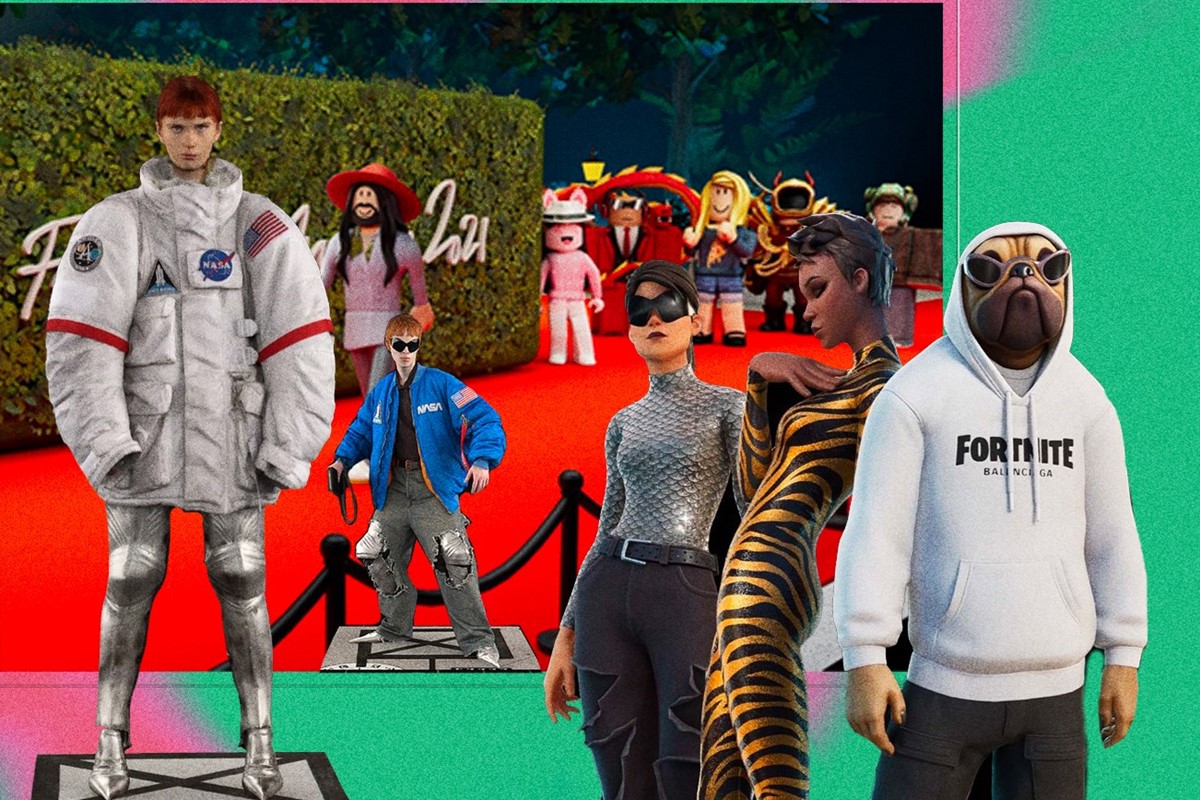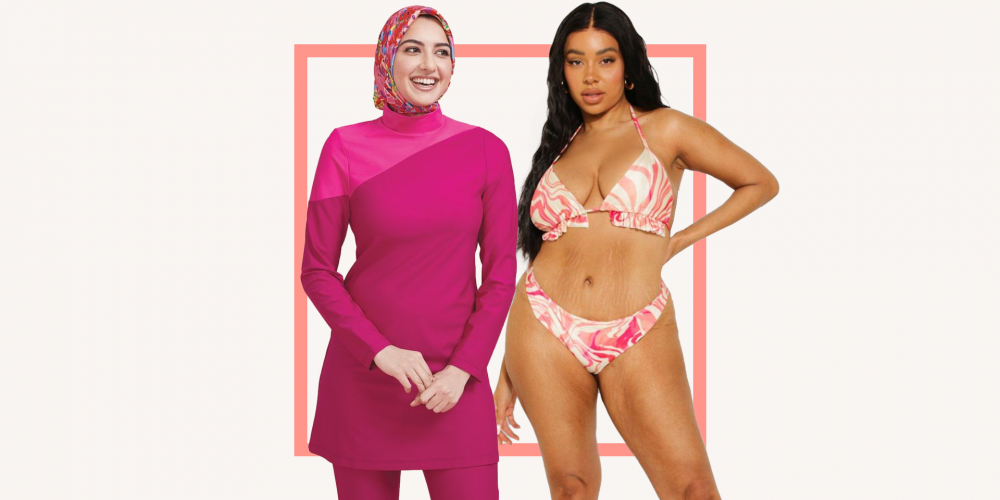
How fashion got swallowed by the metaverse in 2021
The future of the industry lurks on a Web3 blockchain. But how did we get here? And are we any better off for it?
The Y2K renaissance has given us a chance to reflect on the techno-utopianism of the late 90s and early 2000s. J.Lo predicted the surveillance state, Britney Spears wanted us to ‘email her heart’, and through the lens of afrofuturism, TLC, Aaliyah, Busta Rhymes, and Missy Elliott painted a picture of a technological future ruled by PVC-clad cyborgs. It’s no coincidence that in 2021, the resurgence of Y2K aesthetics has converged with fashion entering the metaverse. And what felt like fantasy 20 years ago is today a burgeoning reality – albeit a virtual one.
It’s said to be the next big disruption to the internet as we know it, but what exactly is the metaverse? The word itself was created by Neal Stephenson, who first used it in his 1992 science fiction novel Snow Crash, which depicts a hypothetical future where avatars meet in virtual realities, within hyperreal 3D buildings. Of course, it’s not the first time a science fiction author has inspired real-life inventions. It’s just that Stephenson didn’t predict that everyone in the metaverse would be dressed in head-to-toe Balenciaga.




Historically the fashion industry has been reluctant to jump on the technological bandwagon. In 2008, an international survey of luxury brands by Forrester Research found that only one-third of them actively sold online. But over the course of the last decade, things have changed, and this time fashion is at the forefront.
In 2018, we got our first proper glance at where things were headed. A collective “WTF?” moment saw a new army of AI influencers like Lil Miquela infiltrate the industry – and more importantly, the AW18 Prada show. Following this came a slow trickle of smart tech wearables, including Tommy Jeans’ Bluetooth microchips and John Galliano’s digital nomads, who stomped down the Margiela catwalk with iPhones clamped to their ankles or otherwise built into their backpacks.
Unsurprisingly, the last two years have seen an acceleration in digital transformation thanks to the COVID-19 pandemic. In 2020, designers experimented with everything from the catwalk to virtual spaces. We saw Burberry, Ralph Lauren, Gucci, and Louis Vuitton try out virtual fitting rooms, while LVMH trialled VR showrooms and trade shows. But it wasn’t just the big players. Even rising indie brands like Martine Rose branched out in a new direction, as she presented her SS21 collection via What We Do All Day – an exercise in virtual voyeurism that saw the designer offer a glimpse inside her global community’s homes.
Hey @Balenciaga, what’s the dress code in the metaverse?
— Meta (@Meta) October 29, 2021
Fast forward to 2021, and many of us first heard of “the metaverse” when Mark Zuckerberg announced Facebook’s rebrand as “Meta” in October. Fashion was immediately at the forefront, as the billionaire tech nerd lived out his Clueless fantasy, using his avatar to swipe through an infinite virtual closet. Following the announcement, Meta’s official Twitter account tweeted: “Hey @Balenciaga, what’s the dress code in the metaverse?”
Though Zuck’s Spirit-procured Halloween skeleton suit is unlikely to get the seal of approval from Demna, the designer has spent much of the last year helping to cement Balenciaga as a fashion pioneer of the now rapidly expanding metaverse. After linking up with Fortnite for a virtual and IRL collaboration, the luxury brand partnered with its parent company Epic Games to create Afterworld – a videogame for its AW21 show. A brutalist architecture fan’s dream set in 2031, players were kitted out in full Balenciaga looks before making their way through a dark forest to a forbidden rave. Unsurprisingly, in a sea of short films, the Georgian designer’s interactive foray was the most unique digital runway we’ve seen yet.
Since then, social networking platform IMVU staged its own digital runway show, inviting designers including Collina Strada, Mowalola, and Gypsy Sport to translate their designs into a new medium, before London-based design duo Stefan Cooke partnered with The Sims 4 to make clothes available to gamers as part of its Modern Menswear Kit. Meanwhile, luxury houses like Louis Vuitton, Hermès, and Burberry spent 2021 getting into the NFT game, with JW Anderson closing out the year making an NFT of that viral Harry Styles cardigan.
It goes without saying that 2021 also belonged to the NFT. Though the art world heralded the arrival of the Non-Fungible Token (virtual certificates of ownership based on blockchain technology), they’re very much part of the future of fashion and the next phase of the internet – otherwise referred to as Web3 or Web 3.0. This third iteration of the world wide web operates on decentralised platforms powered by public blockchains, which we’re already seeing with cryptocurrency and NFTs.
Though for now, NFTs and the metaverse are fairly separate, Zuckerberg’s foray into the latter suggests the future will see us moving around the digital realm with our URL belongings. RTFKT (pronounced ‘artifact’) is one of many labels blending the two landscapes. The sneaker studio of the future pairs NFTs with IRL versions of its shoes, and its vision to ‘merge culture and gaming’ caught the attention of Nike, who acquired RTFKT for an undisclosed sum in December 2021. adidas is also getting in on the action, teaming up with Bored Ape Yacht Club, PUNKS Comic, and gmoney to sell a limited edition collaborative NFT that completely sold out – with the German sportswear behemoth banking more than $22 million in the process.
Big businesses might be legitimising NFTs, but for people who love owning real-life material goods, right now, they can seem a little pointless. What’s the point in owning a Birkin NFT if you can’t even hold it? But it’s all about flexing what you own, which isn’t too dissimilar from what hypebeasts do with Supreme bricks.
Today, people that own NFTs can flaunt their new drip on VRChat with their avatars. While there are limits to where you can take your digital fits – which means you can’t take your IMVU low rise jeans into Fortnite – these boundaries may soon disappear. If Web 3.0 develops the way Zuckerberg predicted in his Meta announcement, then blockchain will enable us to have one avatar that can traverse through the infinite terrain of the internet, taking that NFT wardrobe from Fortnite to Roblox and even into work meetings, social gatherings, and who even knows what else.
If that’s the case, then you better start building your virtual wardrobe. The Dematerialised, a “Web3 Marketspace, powered by the LUKSO Blockchain” is where you can start honing your digital style. Founded by Marjorie Hernandez and Karinna Nobbs, the digital department store sells authenticated virtual goods. A 90s inspired, flame belted jumpsuit from Rebecca Minkoff complete with a matching bag will set you back 500€ while a pair of boots from a collaboration between Shoes 53045 and Rico Nasty are marked at 50€ – too bad most items are already sold out.
The metaverse doesn’t come without very real issues, however. Already, issues surrounding authenticity, energy consumption, and user rights are stirring hesitancy about Web 3.0 in some. You may have heard about Birkin NFTs being a hot commodity in the metaverse already, but in December Hermès released a statement that it “did not authorize nor consent to the commercialization or creation” of around 100 MetaBirkin NFTs created by artist, Mason Rothschild. Rothschild’s “Baby Birkin” Bag NFT was sold for $47,000 – or 10 Ethereum – through online marketplace Basic.Space. “These NFTs infringe upon the intellectual property and trademark rights of Hermès and are an example of fake Hermès products in the metaverse,” the company added.
Then there are the issues of user rights in the metaverse. “We have to be mindful of who colonises our future and our metaverse,” explains futurist fashion forecaster Geraldine Wharry. “Who will hold the data of private citizens, how will it be used, where is the autonomy, privacy and agency of the end-user safeguarded?” A lot of these questions don’t have answers yet. Hypothetically, governments could introduce legal protections, though the law has always been slow to catch up with the internet. Others worry the problems that exist in social media will only be quadrupled in the metaverse, or worse, that the data tracked could be as intimate as facial expression and blood pressure.
One issue digital fashion could alleviate, if not solve, is the industry’s devastating impact on the environment. “Digital fashion offers the opportunity to sample and visualise clothing pre-mass-production very realistically, that is one thing that will greatly reduce our environmental impact,” Wharry explains. “It may curb people’s appetite for more clothes and ‘fast fashion fixes’, if they start to identify with their digital twins and avatars, and change how they value the way they look, dress, or even wear make-up.”
“We have to be mindful of who colonises our future and our metaverse. Who will hold the data of private citizens, how will it be used, where is the autonomy, privacy and agency of the end-user safeguarded?” – Geraldine Wharry, future trend forecaster
On the other hand, though making less physical clothes may reduce the industry’s impact on the planet, we’ve already seen the damaging energy costs that come with mining cryptocurrency, so can the metaverse fare any better? In 2019, researchers at the University of Massachusetts completed a life cycle assessment for training several common large AI models. They discovered that training a single AI model can emit as much as 626,000 pounds of carbon dioxide, which is almost five times the lifetime emissions of the average American car. Wharry is hopeful that with a new landscape, there will be new solutions. “The metaverse is not a total panacea, but it offers the possibility of relieving pressure from the extraction of raw materials to produce clothing. The energy is taken from somewhere else at the moment, it is not ‘zero waste’, but solutions are evolving quickly.”
It may feel like a bold and sometimes imperceptible new world right now, but it was only three years ago that AI influencers and digital models like Lil Miquela felt like a dystopian sneak peek into the future. But the digital fashion revolution is well and truly here, and 2021 was just the beginning. While luxury brands like Balenciaga have led the way so far, it’s only a matter of time before we see everyone from high street chains, to small indie designers dipping their toes into the vast expanse of the metaverse. What will you be wearing when they do?



